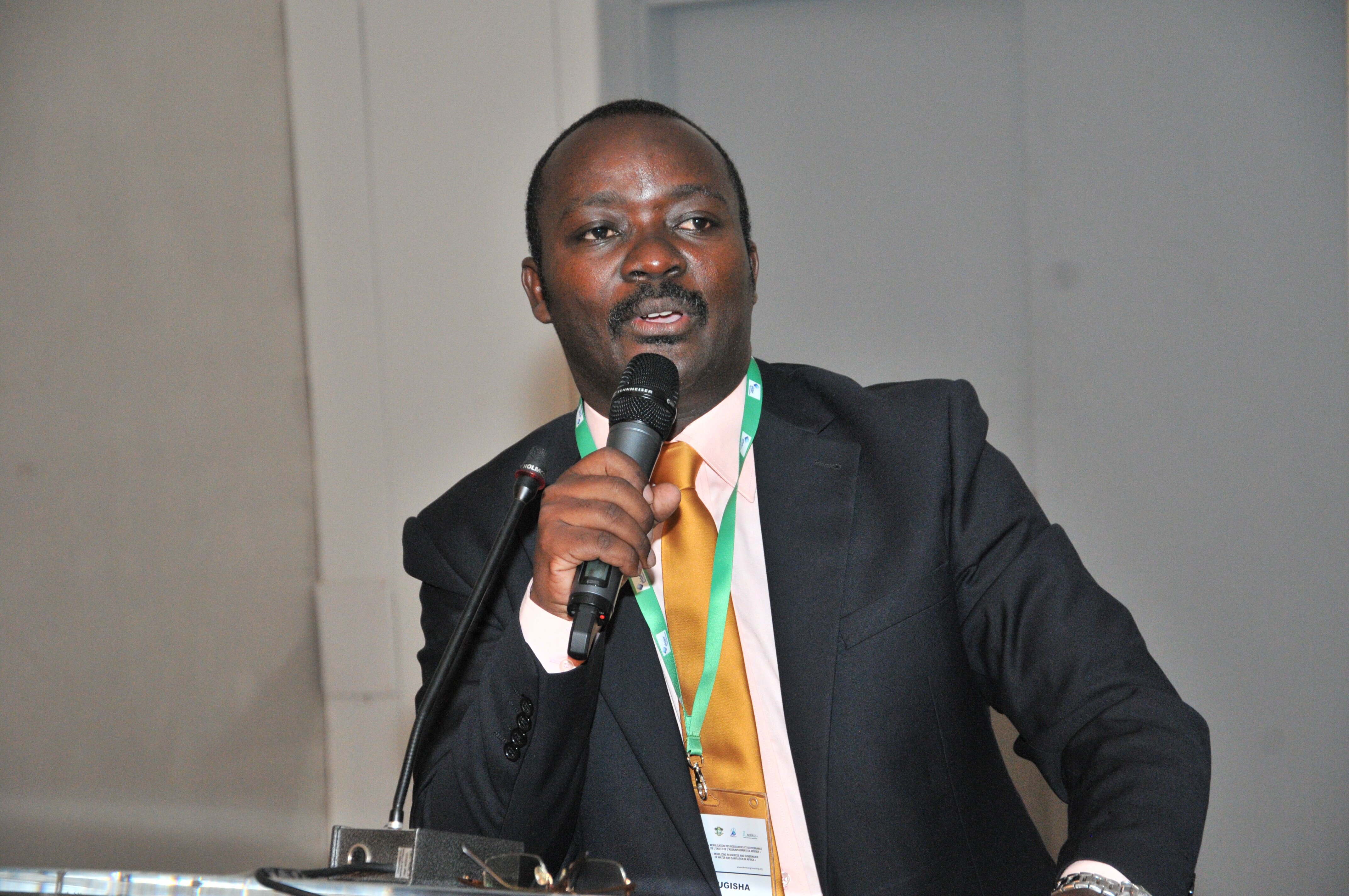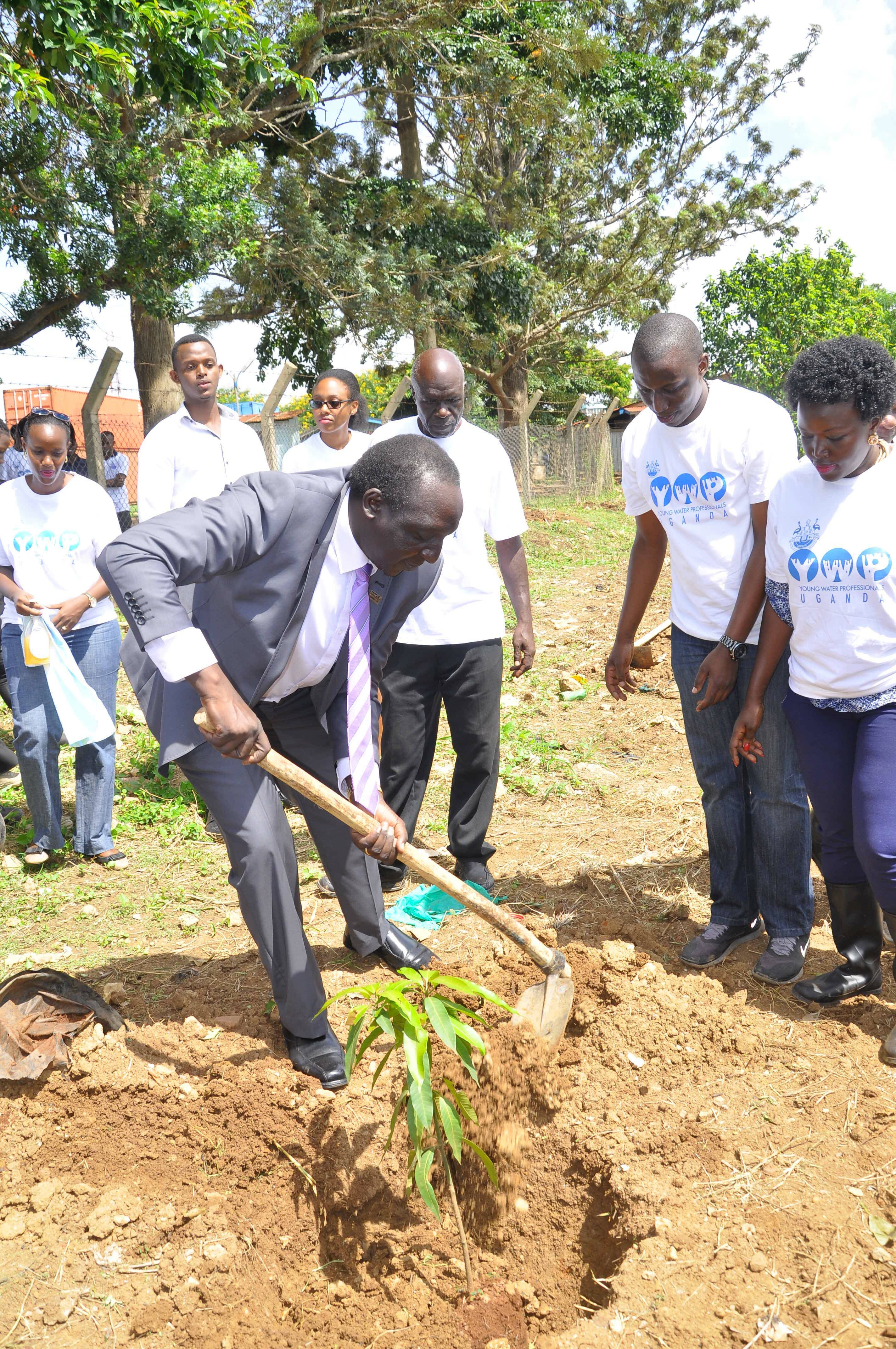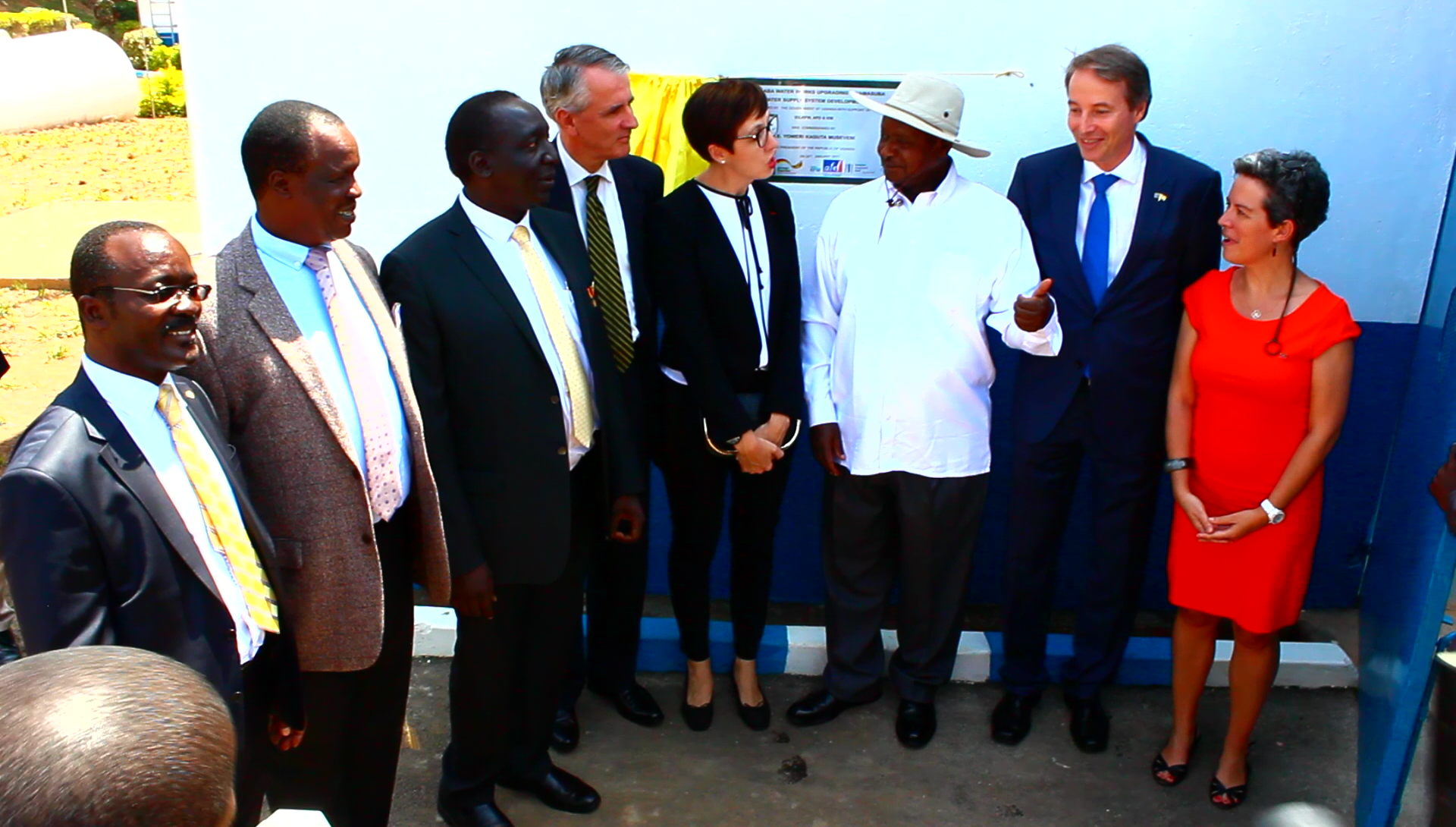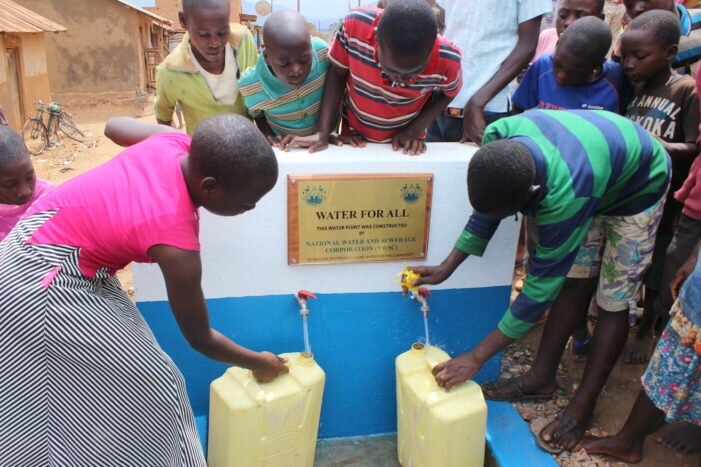
The Government has recognized the cross-benefit of access to safe drinking water and improved sanitation, and has in the last decade made substantial progress in terms of increasing coverage. According to the Minister of Water and Environment, Hon Sam Cheptoris the Government of Uganda is committed to ensure that every village in Uganda has a clean water source in order to achieve the National strategic aspiration of achieving 100% service coverage by 2020.
The national goal of Uganda’s water supply and sanitation sector is to increase urban and rural access to water supply services from 77% and 65% respectively to 100% and 79% by 2020.
Having expanded its service footprint from 24 to 225 towns in the last four years, NWSC and Government of Uganda have rolled out a project to connect water to 12,000 villages by 2020 within NWSC operational areas.
The 100% Service Coverage Acceleration Project (SCAP100) is jointly funded by Government of Uganda and NWSC. From project commencement in July 2017 to March 2018, NWSC has already distributed 1500kms of water pipes to NWSC service areas across the country.
The NWSC financing component is from internally generated resources. The total budget of the project over the three-year period is Ushs 213 billion, with Ushs 90 billion expected from Government, and annual budgetary provisions of Ushs 30 billion will be made under the medium term budget framework and the annual Water and Environment Ministerial policy statement across the three-year period.
The project focusses on villages with sufficient network but limited public water points. It will also serve villages close to the network and villages that are far but could be served from the existing network. Additionally it will also serve villages that are far but can be served after ongoing or planned major capital development/upgrades on the existing system. The project will also improve functionality of all systems in line with the Assets management strategy.
National Water and Sewerage Corporation (NWSC) is a public parastatal wholly owned by the government of Uganda, having been established in 1972 by decree No. 34. The principal business of the Corporation as defined in the NWSC Act is to operate and provide water and sewerage services in areas entrusted to it on a sound commercial and financially viable basis.
Over the last decades, NWSC has made significant progress in improving service delivery in its Areas of jurisdiction which is in line with the National strategic objective of universal and equitable access to safe and affordable drinking water for all. In spite of the progress, there are still disparities in potable water and improved sanitation coverage across and within districts and regions, affecting some of most marginalized and poor in the country.
In 2013, the Corporation launched a Five Year Strategic Direction (SD) 2013-2018 with the primary objective of increasing geographical coverage and accelerating service delivery to achieve 100% coverage. In June 2016, the SD was rolled over to the period 2016-2021 to take care of the new developments within the Water and Environment Sector as well as the key emerging issues in line with National Strategic Framework and Government Policy expectations aligned to the Government Manifesto 2016-2021, National Development Plan (NDPII), Vision 2040 and the Sustainable Development Goals (SDG).
Within the framework of the SD and guided by the Government policy expectations, the Corporation has gone through rapid expansion of its geographical coverage from 23 towns in 2013 to 225 towns in over 75 districts across the country as of March 2018. Whereas the Corporation has managed to achieve service coverage in the traditional 23 towns to over 77%, there are still disparities in the water service coverage for the new towns taken over and the surrounding areas which NWSC is targeting to serve. Out of the 15,500 villages targeted to be served by NWSC, only 5,000 have full access to piped water supply and these are largely located in the traditional 23 towns and the town centers. Majority of the remaining 10,500 villages are characterized by distant unreliable and unsafe water sources.
In conformity with the thrust of the SDGs, NDPII, Vision 2040, and Government Manifesto 2016-
2021, NWSC’s strategic focus for the period 2016-2021 is on two pillars: (i) infrastructure development and (ii) 100% reliable service delivery. Under the first pillar, the Corporation intends to focus on the development and rehabilitation of its critical water supply and sewerage infrastructure.
The second pillar targets increasing the Corporation’s geographical coverage and 100% water supply coverage. To this end, the NWSC strategic focus in the next four years is to address equity in service delivery and achieve 100% water service coverage in all the villages under its jurisdiction.
Water Service Acceleration Project
The NWSC is currently operating in 225 gazetted towns across the country with a total of 15,500 villages as per the Uganda Bureau of Statistics (UBOS) database. The objective of the Corporation as defined in the Corporate Plan 2015-2018 and the Five Year Strategic Direction 2016-2021 is to achieve 100% water service coverage in all its areas of operation through a number of pragmatic interventions among which include installation of Public Stand Pipes (PSPs) that mainly target the unserved and disadvantaged communities. The table below summarizes on a regional basis, the number of villages and population with and without 100% piped water supply.
Table 1 Summary of villages and population with and without 100% piped water supply
| # | Region | Villages under NWSC | Villages with 100% piped Water | Villages without 100% piped Water | |||
| No. Villages | Population | No. Villages | Population | No. Villages | Population | ||
| 1 | Kampala | 858 | 1,813,600 | 858 | 1,813,600 | – | – |
| 2 | Central Region | 4,342 | 6,443,127 | 817 | 3,262,165 | 3,525 | 3,180,962 |
| 3 | Western Region | 6,363 | 4,351,200 | 2,223 | 1,778,151 | 4,140 | 2,573,049 |
| 4 | Eastern And Northern | 3,857 | 3,042,347 | 913 | 1,084,726 | 2,944 | 1,957,621 |
| Total | 15,420 | 15,650,274 | 4,811 | 7,938,641 | 10,609 | 7,711,632 | |
Note: The data on villages and population (projected to 2020) is derived from National Bureau of Statistics
The 100% Water Service Acceleration Project (SCAP100) is in line with the Government policy direction of ensuring 100% service coverage in all villages across the country. The SCAP100 aim is to ensure that the 10,609 villages and the 7.7 million people have access to reliable and safe drinking water by 2020. The project will build on the extensive service expansion experience the Corporation has acquired over years and will further strengthen and consolidate gains achieved by the Corporation.
NWSC commits to serve more
In the last three years NWSC has undertaken a systematic and quite aggressive expansion of the geographical coverage that has resulted into an increase of the number of NWSC service towns from 23 to 225 towns, with an estimated 15,500 villages across the Country both within and outside the gazetted areas. Whereas the Corporation has managed to achieve service coverage in the traditional 23 towns to over 77%, there are still great disparities in the water service coverage mainly in the new towns taken over and the surrounding areas which NWSC is targeting to serve. Out of the 15,500 villages targeted to be served by NWSC only 5,000 have full access to piped water supply and these are largely located in the traditional 23 towns and the town centers. The majority of the remaining 10,500 villages are characterized by distant unreliable and unsafe water sources.

This means that 68% of the villages with an estimated population of about 7.7 million do not have access to reliable piped water supply. In addition, there is also a sporadic disparity between the regions, districts and villages, and within districts and villages. This is caused by a number of factors including the location of water resources, climate and weather conditions and the level/type of community settlement among others.
Whereas the NWSC has attempted to intensify water supply in the gazetted areas, through implementation of the Infrastructure Service Delivery Plans (ISDPs) and Water Stabilization Plans (WSPs) that have greatly enhanced water network expansion and production, there are a number of villages especially in the new towns that are water stressed. To be able to serve these areas, the Corporation needs to implement a mix of service delivery options including system upgrade, development of new mini-systems and network expansion and intensification focusing on the unserved areas.
Speaking about SCAP100, The MD of NWSC Eng. Dr. Silver Mugisha said, “With the current 68% of the villages having no access to safe water, if no quick win interventions are made in the medium term focusing on individual villages, the Country will not be able to achieve the strategic agenda of 100% water supply coverage. The NWSC focus in the next three years is to ensure at least every 200 people (15-20 households) in each village under NWSC areas of jurisdiction have a public stand post (PSP)”
Equity and advancement of the poor
Notable progress has been made both by the Ministry of Water and Environment and NWSC to ensure that every Ugandan has access to safe drinking water and improved sanitation. However, there are still great disparities in the national service coverage across and within regions and districts, affecting some of most marginalized and poor in the country. There are a number of villages under NWSC within the same region and district that are adequately served and many that are water stressed. The least served communities have no available water source options and in most cases no possibility of common water supply technologies.
The NWSC focus under the Strategic Direction 2016-2021, and which the SCAP100 project will purposely address is the reduction in water supply inequality within its service area and ensure that every village is adequately served with reliable safe drinking water.
Middle income status by 2020
The Government of Uganda’s target is to attain a middle income status by 2020 and the same context the National goal for water supply and sanitation sector is to increase urban and rural access to water supply services from the current 71% and 67% respectively to 100% and 79% by 2020. The SCAP100 project shall support the GoU’s efforts to achieve the middle income status by ensuring that the population in every village has 100% access to reliable safe water by the year 2020. The project is therefore aligned to the following National Strategic Planning frameworks;
- NDP II Urban Water and Sanitation Goal: Increase urban water supply from 77 % (2012/13) to 95 % (100 % NWSC towns) (2019/20
- VISION 2040: Increase water consumption (m3 per capita) from 26 to 600, and Increase percentage of the population with access to safe piped water from 15% to 100%.
iii. SDG No.6: Ensure availability and sustainable management of water and sanitation for all
- Target 6.1 by 2030, achieve universal and equitable access to safe and affordable drinking water for all
- Target 6.2 by 2030, achieve access to adequate and equitable sanitation and hygiene for all
- Target 6.3 by 2030, improve water quality, halving the proportion of untreated wastewater, and increasing recycling and safe reuse
- Target 6.4 by 2030, substantially increase water-use efficiency and reduce the number of people suffering from water scarcity
NWSC experience and in-house solutions
Over the past three years, NWSC has undertaken a systematic and quite aggressive expansion of the geographical coverage that resulted in an increase of the number of NWSC service towns from 23 to 208 towns across the country in a space of just 3 years. Modern and strong management systems have been established in all the new towns taken which has greatly enhanced service delivery in these towns.
The Corporation has also implemented massive but systematic rehabilitation, upgrade and expansion of infrastructure through bi-annual Infrastructure Service Delivery Plans (ISDP) and annual Water Supply Stabilization Plan (WSSP) to improve supply reliability and service coverage.

On average, 1,200 km of water pipe network has been extended annually across the country in the last three years compared to an annual average of only 80 km that used to be extended, and 100% system functionality has been achieved in most of the new towns taken over. Similarly, the number of customers have increased by 50% from 317,000 water connections in 2013 to 475,000 water connections as of June 2016. The service expansion programme has been largely financed through NWSC internally generated funds.
The project will build on the extensive service expansion experience the Corporation has acquired in the last three years and will further strengthen and consolidate gains achieved by the Corporation.
The National goal of Uganda’s water supply and sanitation sector is to increase urban and rural access to water supply services from 77% and 65% respectively to 100% and 79% by 2020. The objective of SCAP100 is to support the Government of Uganda’s efforts to accelerate achievement of sustainable provision of safe water, to 100% of the population in the 10,600 villages across the 62 districts in the country by the year 2020.
- Construction of cost effective safe water supply schemes and ensuring 100% system functionality;
- Installation of 140,000 new water connections and 20,000 Public Stand Pipes (PSPs) by 2020; two PSPs per village and one PSP per 200 people;
- Water service expansion through installation of a total of 8,000 km of pipe extension and intensification per annum
Who will benefit?
As at 30th June 2017, the NWSC operated in 208 towns spread over 70 Districts, 400 sub counties, and 15,500 villages. The number of administrative areas are projected to grow to about 80 districts with over 200 operational areas by 2020.
The proposed SCAP100 project will target the 12,000 villages (within the 80 districts across the country) that do not have 100% access to reliable piped water supply. Table.2 below summarizes the various administrative areas that will constitute the project area. Table 2 Project Area
| # | Region | Districts | No. Villages | Population |
| 1 | Central | 21 | 3,525 | 3,180,962 |
| 2 | Western | 20 | 4,140 | 2,573,049 |
| 3 | Eastern and Northern | 21 | 2,944 | 1,957,621 |
| 4 | Projected new districts/towns | 18 | 1,391 | 788,368 |
| Total | 80 | 12,000 | 8,500,000 |
How many people will benefit
The estimated population for all the 15,500 villages under NWSC based on 2014 population census is about 14 million people as of 2016 and by 2020 the total projected population under NWSC shall be about 16.4 million people considering a population growth rate of 3.03% and additional towns to be taken over. The target population for the project shall be 8.5 million people as summarized in Table 3 below.
Table 3: Population data
| # | Region | Population 2016 | Projected Population 2020 | ||
| 100% Served | Project Area population | Total population 2020 | |||
| 1 | Central including Kampala | 7,327,455 | 5,075,765 | 3,180,962 | 8,256,727 |
| 2 | Western | 3,861,483 | 1,778,151 | 2,573,049 | 4,351,200 |
| 3 | Eastern and Northern | 2,699,939 | 1,084,726 | 1,957,621 | 3,042,347 |
| 4 | Projected new districts/towns | 788,368 | 788,368 | ||
| Total | 13,888,877 | 7,938,641 | 8,500,000 | 16,438,642 | |
Which villages will be benefit?
The project will adopt a combination of technical solutions based on the existing water supply status of the villages. Three main components will be adopted and these include the following;
- Component 1: Villages with sufficient network but limited public water points. The villages that fall under this category have existing network but lack adequate PSP connections for accessibility of water. The interventions under this category will include network intensification and constructions of PSPs at suitable locations to ensure that One PSP serves 200 people and each village has at least two PSPs.
- Component 2: Villages close to existing network but have access. The villages that fall under this category are close to existing network but require extensions and intensifications to increase network penetration and construction of PSP to ease access to water supply. The intervention under this category shall involve network extensions and intensifications as well as constructions of PSPs at suitable locations to ensure that One PSP serves 200 people and each village has at least two PSPs.
- Component 3: Villages that are far or cannot easily be served from existing network. The villages that fall under this category are far off and cannot easily be supplied from the existing network. The interventions shall involve a menu of options including; developing on mini-systems (gravity scheme/motorized pump scheme, extension of water supply systems from existing systems and protected springs, pumping and storage facilities), promoting renewable energy (solar systems) and construction PSPs to serve the community.
- Component 4: Villages that are far or cannot easily be served from existing network but benefit from an ongoing/planned major capital project. The villages that fall under this category cannot be feasibly supplied from the existing network but are to benefit from an on-going or planned major project. The intervention under this category is to connect the villages to the major project infrastructure through network extensions/intensifications and construction of PSPs.
The proposed SCAP100 project is not a stand-alone project but rather will be implemented alongside and will supplement the other service expansion interventions by the Corporations.
Expected outcomes.
A number of project outcomes and outputs shall be realized and are described as follows;
Permanent infrastructure will be built and shall include pipe lines, reservoirs or tanks, booster pumps, mini-water systems (gravity/motorized pump schemes) and PSPs among others. This infrastructure will be very important in ensuring 100% piped water service coverage in all the villages.
Increase in Safe Water Coverage
About 8.5 million people will have access to safe water thus there will be increase in percentage of population with access to piped safe drinking water through provision of a water supply point for every 200 people. It is envisaged that by end of the project period, all the villages under NWSC supply areas will have access to piped water supply in line with the overall objective of achieving 100% service coverage.
Over 20,000 PSPs will be constructed and 140,000 new water connections installed. This will significantly improve accessibility to water supply in all villages within the project area. The operation and maintenance of the systems shall be properly planned in line with the asset management practices of the Corporation to ensure 100% functionality. The management of the PSPs will be undertaken through partnership and collaboration with the communities.
The main indicators defined for monitoring the project’s output are in line with NWSC monitoring and evaluation framework with particular focus on access, functionality, compliance with water quality standards, per capita consumption of water, equity, and gender (percentage of women operating the PSPs), among others. The KPIs will be monitored on a monthly basis to assess the level of achievement, challenges and then institute strategies to address the challenges. Some of the KPI for the project and expected outputs are summarized in Table 4 below.
Table 4: Project Targets
| # | Indicator | Unit | Target |
| 1. | % population with access to safe water | % | 100 |
| 2. | % of villages with at least two public water points | % | 100 |
| 3. | No. of new public water points installed | No. | 19,500 |
| 4. | No of new water connections installed | No. | 140,000 |
| 5. | Total water pipe network installed | km | 7,500 |
Implementation arrangements
Detailed Engineering Designs
The engineering designs of the systems have been and will be undertaken in-house by the Corporation staff as opposed to Private/Independent Consultants to optimize costs. The designs have adopted the use of low cost systems/facilities e.g. utilization of solar energy for pumping as considerably as possible. The design of the system shall use information collected on the water supply situation for the villages and population data from Uganda Bureau of Statistics (UBOS).
Construction and implementation and implementation
Construction and implementation phase has adopted and will continue to use low cost approach to promote cost efficiency and effectiveness. The approach shall adopt the use of framework contracts in acquisition of materials/requirements/inputs thus save costs and optimize on time undertaken for acquisition. Labour/works contracts shall be secured in line with the PPDA provisions and to the largest extent possible, the force accounts approach will be adopted during the implementation of the Project.
Construction Supervision and Mobilzation
Supervision of the construction works will be undertaken by the Corporation staff to ensure effective and efficient project implementation. This will include inspections, monitoring, quality assurance, site meetings, keeping records of the construction works and preparation of monthly/quarterly reports and certificates. The mobilization component shall include sensitization of the beneficiary communities on their roles and responsibilities and creating awareness on the general issues of water supply.
Project Management and Coordination
The implementation of works shall be undertaken at the Area/Town level but the procurement of inputs shall be handled centrally to benefit from economies of scale. The overall coordination of the Project shall be handled centrally by a project manager who will coordinate with the respective appointed contract managers at the Areas/Towns level for effective supervision, coordination and monitoring of the Project works. In addition, NWSC at the area level will work with the local leadership in identification of various project sites and also ensure stainability of the various water infrastructure.
Summary of implementation Items and Dates
The implementation of the works shall be phased over a three-year period, starting from the FY 2017/2018 to FY 2019/2020 for cash flow outlays. Budget provisions shall be made every year for the purpose of implementing this project. The table below shows the activities to be carried out.
| Date | Task | Plan of Operation | Status |
| September 2016 | Preparation of the Project Proposal for Service Coverage Acceleration Project | Done In-house | Done |
| Oct 2016 | Detailed Engineering design of the Systems |
To be done in-house by Corporation
Staff from the skills already developed |
Done |
| May 2017 | Framework contracts in place | Utilize framework contracts for supply of pipes. Works to be done using force accounts | Done |
| July 2017 |
Commencement of project
implementation |
Contract management and reporting on progress | Ongoing |
| July2017-July2020 | Project execution | Project implementation and regular reporting on progress | Ongoing |
Overall strategy
Overall, the strategy of the project is to accelerate the achievement of GOU expectation of 100% service coverage in all villages across the country through prudent use of limited available resources and exploitation of the already developed internal capacity in NWSC.
Capital Financing Arrangement
The project will be financed by both Government and the NWSC. The NWSC financing component will be from internally generated resources. The total budget of the project over the three-year period is Ushs 213 billion, with Ushs 90 billion expected from Government, and annual budgetary provisions of Ushs 30 billion will be made under the medium term budget framework and the annual Water and Environment Ministerial policy statement across the three-year period.
***SPONSORED


Disclosure: TheUgandan runs sponsored posts— the disclosure message is marked at the end of each article using the word “sponsored.” This website develops sponsored content with companies whose products and services we think our readers will find valuable or interesting.





You must be logged in to post a comment Login